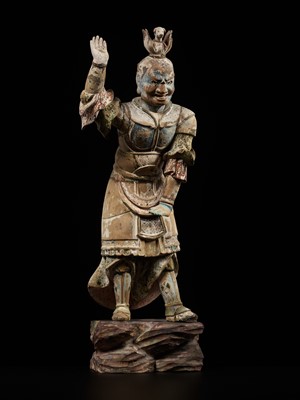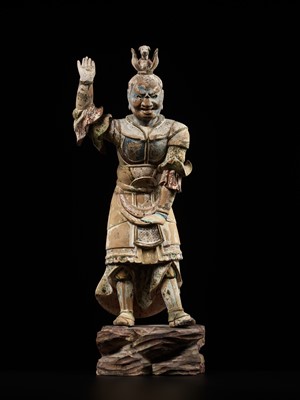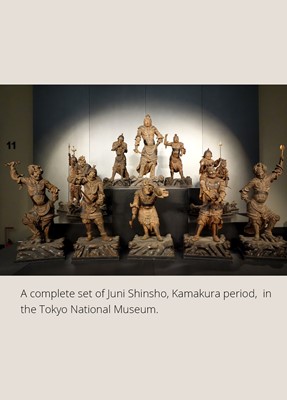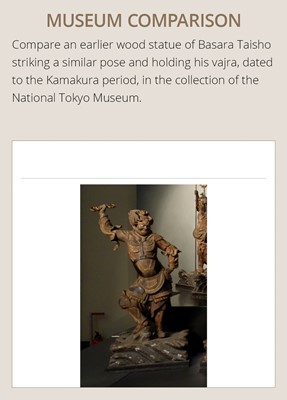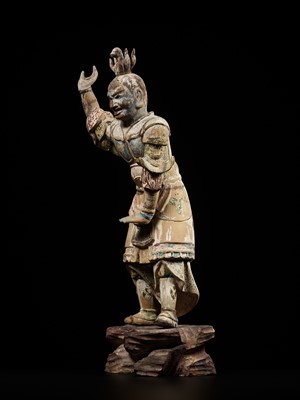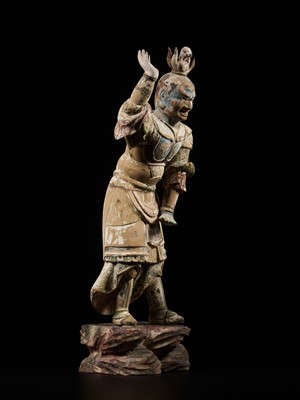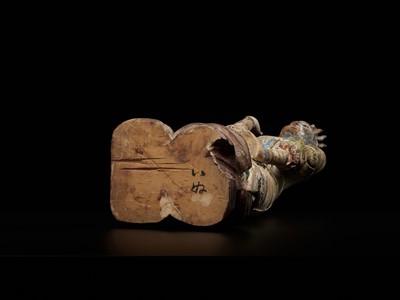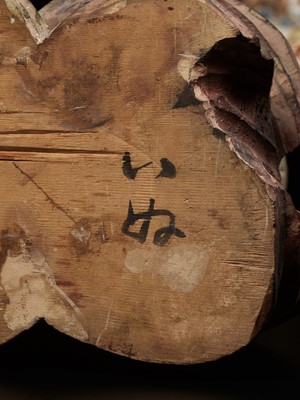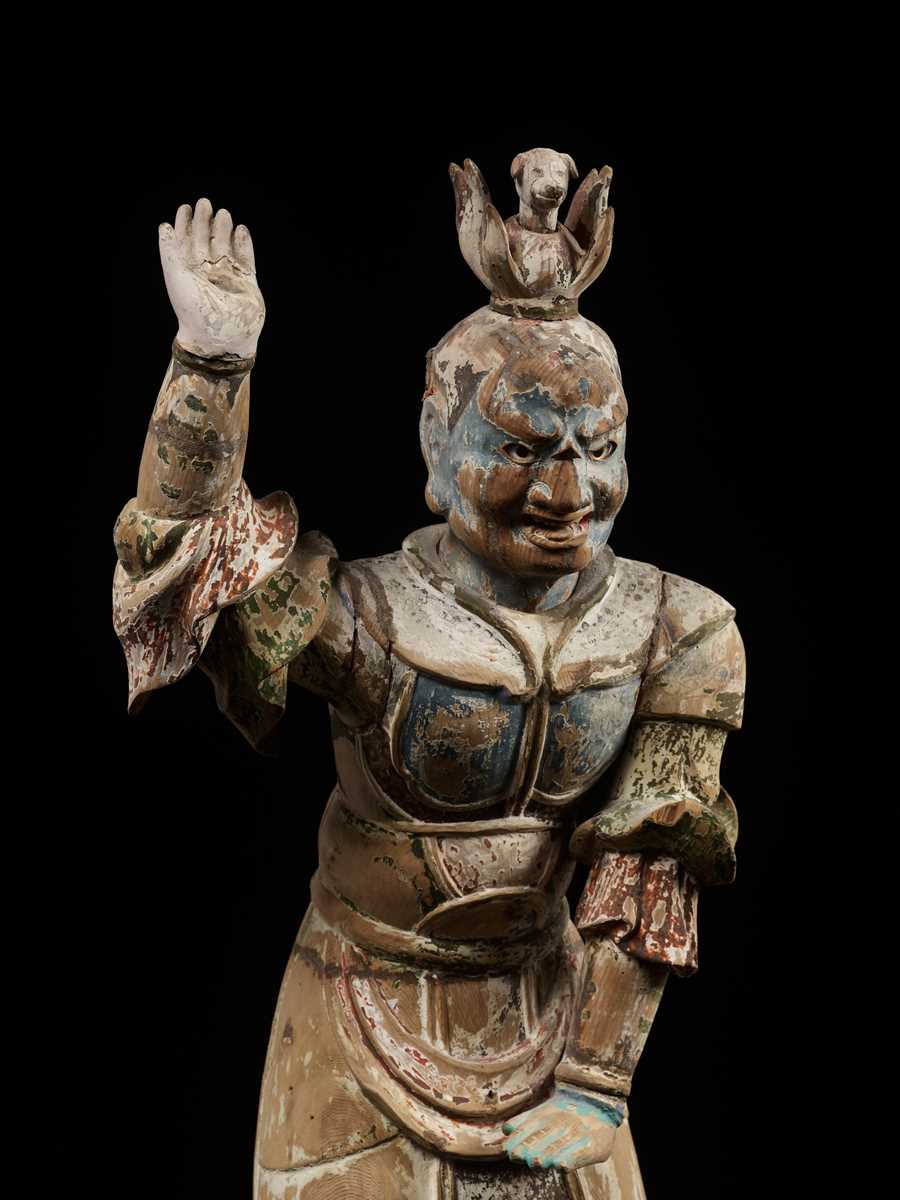1st Dec, 2023 13:00
Fine Japanese Art
43
A POLYCHROME WOOD FIGURE OF BASARA TAISHO (DOG GENERAL), LATE MUROMACHI TO EDO
Sold for €1,300
including Buyer's Premium
Japan, 16th-17th century, late Muromachi period (1336-1573) to early Edo period (1615-1868)
Finely carved and painted in polychrome pigments, the heavenly general standing in a fierce battle pose atop a wood base with his right hand raised above his head holding what was once a vajra, his left hand reaching towards his knees. His blue face is set with a grizzly expression, baring his teeth, his wild eyes made of black and gold lacquer on ivory painted red in the corners beneath a transparent rock crystal inlay. He wears a tiger skin cloth and heavy armor painted in elaborate colors with fine details to the hems, depicting dharma wheels and foliate designs, his hair pulled into a tight topknot, flying upwards, with a dog’s head protruding from the top.
HEIGHT 60.9 cm
Condition: Wear, some chips, expected age cracks, extensive flaking to pigments, losses, and possible old repairs.
Provenance: From a private collection in Vienna, Austria.
The Twelve Heavenly Generals, also known as Juni Shinsho, are the protective deities of Yakushi (Bhaisajyaguru in Sanskrit) and his followers; Bhaisjyaguru is the buddha of healing and medicine in Mahāyāna Buddhism. Each of the Twelve Divine Generals embodies a vow taken by Yakushi to heal ailments of the body and mind. Responsible for protecting the faithful and vanquishing the enemies of Buddhism, they are depicted with ferocious countenances, wearing armor, and standing in fighting poses. In ancient times they became associated with the twelve animals of the Chinese zodiac and were often the subject of sculptures during the Heian and Kamakura periods. It is believed that sculptures of the Heavenly Generals were enshrined in temples, since several in the Tokyo National Museum are believed to be from the Joruri-ji temple of the school of Pure Land Buddhism in Kizugawa, Kyoto prefecture. Many of these sculptures were votive offerings made by a nobleman, and many sculptors of these figures belonged to the famous Kei school of Buddhist sculpture that emerged in the early Kamakura period.
Museum comparison:
Compare an earlier wood statue of Basara Taisho striking a similar pose and holding his vajra, dated to the Kamakura period, in the collection of the National Tokyo Museum.
Japan, 16th-17th century, late Muromachi period (1336-1573) to early Edo period (1615-1868)
Finely carved and painted in polychrome pigments, the heavenly general standing in a fierce battle pose atop a wood base with his right hand raised above his head holding what was once a vajra, his left hand reaching towards his knees. His blue face is set with a grizzly expression, baring his teeth, his wild eyes made of black and gold lacquer on ivory painted red in the corners beneath a transparent rock crystal inlay. He wears a tiger skin cloth and heavy armor painted in elaborate colors with fine details to the hems, depicting dharma wheels and foliate designs, his hair pulled into a tight topknot, flying upwards, with a dog’s head protruding from the top.
HEIGHT 60.9 cm
Condition: Wear, some chips, expected age cracks, extensive flaking to pigments, losses, and possible old repairs.
Provenance: From a private collection in Vienna, Austria.
The Twelve Heavenly Generals, also known as Juni Shinsho, are the protective deities of Yakushi (Bhaisajyaguru in Sanskrit) and his followers; Bhaisjyaguru is the buddha of healing and medicine in Mahāyāna Buddhism. Each of the Twelve Divine Generals embodies a vow taken by Yakushi to heal ailments of the body and mind. Responsible for protecting the faithful and vanquishing the enemies of Buddhism, they are depicted with ferocious countenances, wearing armor, and standing in fighting poses. In ancient times they became associated with the twelve animals of the Chinese zodiac and were often the subject of sculptures during the Heian and Kamakura periods. It is believed that sculptures of the Heavenly Generals were enshrined in temples, since several in the Tokyo National Museum are believed to be from the Joruri-ji temple of the school of Pure Land Buddhism in Kizugawa, Kyoto prefecture. Many of these sculptures were votive offerings made by a nobleman, and many sculptors of these figures belonged to the famous Kei school of Buddhist sculpture that emerged in the early Kamakura period.
Museum comparison:
Compare an earlier wood statue of Basara Taisho striking a similar pose and holding his vajra, dated to the Kamakura period, in the collection of the National Tokyo Museum.
Zacke Live Online Bidding
Our online bidding platform makes it easier than ever to bid in our auctions! When you bid through our website, you can take advantage of our premium buyer's terms without incurring any additional online bidding surcharges.
To bid live online, you'll need to create an online account. Once your account is created and your identity is verified, you can register to bid in an auction up to 12 hours before the auction begins.
Intended Spend and Bid Limits
When you register to bid in an online auction, you will need to share your intended maximum spending budget for the auction. We will then review your intended spend and set a bid limit for you. Once you have pre-registered for a live online auction, you can see your intended spend and bid limit by going to 'Account Settings' and clicking on 'Live Bidding Registrations'.
Your bid limit will be the maximum amount you can bid during the auction. Your bid limit is for the hammer price and is not affected by the buyer’s premium and VAT. For example, if you have a bid limit of €1,000 and place two winning bids for €300 and €200, then you will only be able to bid €500 for the rest of the auction. If you try to place a bid that is higher than €500, you will not be able to do so.
Online Absentee and Telephone Bids
You can now leave absentee and telephone bids on our website!
Absentee Bidding
Once you've created an account and your identity is verified, you can leave your absentee bid directly on the lot page. We will contact you when your bids have been confirmed.
Telephone Bidding
Once you've created an account and your identity is verified, you can leave telephone bids online. We will contact you when your bids have been confirmed.
Classic Absentee and Telephone Bidding Form
You can still submit absentee and telephone bids by email or fax if you prefer. Simply fill out the Absentee Bidding/Telephone bidding form and return it to us by email at office@zacke.at or by fax at +43 (1) 532 04 52 20. You can download the PDF from our Upcoming Auctions page.
How-To Guides
How to Create Your Personal Zacke Account
How to Register to Bid on Zacke Live
How to Leave Absentee Bids Online
How to Leave Telephone Bids Online
中文版本的操作指南
创建新账号
注册Zacke Live在线直播竞拍(免平台费)
缺席投标和电话投标
Third-Party Bidding
We partner with best-in-class third-party partners to make it easy for you to bid online in the channel of your choice. Please note that if you bid with one of our third-party online partners, then there will be a live bidding surcharge on top of your final purchase price. You can find all of our fees here. Here's a full list of our third-party partners:
- 51 Bid Live
- EpaiLive
- ArtFoxLive
- Invaluable
- LiveAuctioneers
- the-saleroom
- lot-tissimo
- Drouot
Please note that we place different auctions on different platforms. For example, in general, we only place Chinese art auctions on 51 Bid Live.
Bidding in Person
You must register to bid in person and will be assigned a paddle at the auction. Please contact us at office@zacke.at or +43 (1) 532 04 52 for the latest local health and safety guidelines.

